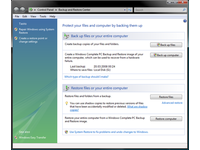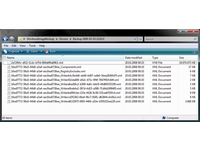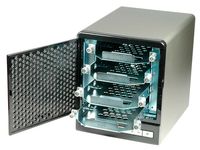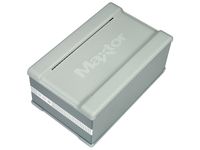Benchmarking With Intel's NAS Toolkit
Implementing NAS
As has already been mentioned, NAS units can be used for more than just storing data on a network. The value of additional functions provided in some NAS devices should not be underestimated. Here, NAS units must cover a wide range of different requirements which vary according to user type and intended use.
Demanding The Most From NAS
We can see the differences in NAS performance with an example like this one: if you use Windows Vista’s integrated backup utility, all data is written to a backup file that can be several gigabytes large, depending on the system you’re saving. If the backup file is created over the network directly on the NAS unit during the backup process itself, the use of sequential transfer means that you’ll realize data rates vastly different from what you’d see opening and saving small documents. Unlike backup files, office documents are usually only a few kilobytes in size, which puts other demands on the NAS unit in terms of reading or writing of the files.


Differentiated Observation
If you start multi-tasking from the NAS and start simultaneously reading and writing media files—in particular, video files—you can see why an NAS unit needs to be a real all-around performer. In order to get a meaningful idea of the performance capabilities of a NAS unit, it is not sufficient to just to transfer a file of several gigabytes to and from the NAS, record the time it takes and use this information to determine the transfer rates.
This method may be suitable for providing a frame of reference, but the requirements made of a NAS unit are so varied that they cannot be mapped using just a single method. Even so, other test methods, like the use of programs like Iometer, are often too synthetic to provide a meaningful impression of the situation under real conditions.
Introducing A New Benchmark
Get Tom's Hardware's best news and in-depth reviews, straight to your inbox.
In the past, when testing NAS units, we used the benchmarks we developed ourselves—the main focus of which was the copying of smaller files and files of up to a gigabyte in size. But we’re shifting gears and now using the Intel NAS Performance Toolkit to measure performance. This step allows us to take the changed multimedia-related requirements made of NAS units into account, so we can provide you with differentiated and meaningful benchmark results.
Current page: Implementing NAS
Prev Page Hardware And Software RAID Next Page Intel NAS Performance Toolkit-
malveaux Heya,Reply
Nice. Intel released benchmarking software for NAS... NAS?!?! And they wont let it work on AMD cpu's?
Weaksauce.
Cheers, -
smelly_feet To Toms Hardware:Reply
Please add powerconsumption in all your benchmarks (at the wall). The only reason for me to buy a NAS (over a miniitx) is powerconsumption and heat generated. -
malveaux Hrm,Reply
I too am interested in that Smelly_Feet.
As it is, I use an older computer with some drives in it running FreeNAS. I have no real reason to look into stand-alone-options. If however there are things that use less energy all the time, I'd be tempted to switch things around.
Cheers,


